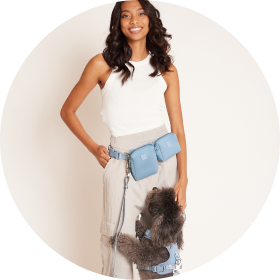- Home
- The Daily Wag!
- Senses
- Can Dogs Feel Cold in Their Feet?

Every species reacts to temperature changes differently. Humans react to the cold by wearing heavy articles of clothing and jackets. Some animals, like bears, go into a deep sleep called hibernation during the colder months, which allows them to survive the severely chilly temperatures.
Our four-legged friends that live with us are no different in that they have to adapt to the changing conditions. Some dogs are able to shed and regrow a coat that specifically helps their body regulate temperatures during the cold months. While this does occur, another thing to consider is whether or not those pups can feel the cold on their feet.
When the weather turns to freezing, we all know just how to prepare. We go out and buy new coats, boots, and gloves. We turn our heat on in the house and we stock up on firewood so that we always have a way to stay warm.
During all of this, we must remember that our favorite canine buddy still needs to go on regular walks and they still need to go outside to do their business. Because of this, your dog will be walking on the cold pavement or through the snow.
When you get back inside, you will want to keep an eye on your pup for these signs that their feet may be a little chilly. If you come back inside and your dog is shaking, this is a good indicator that they are feeling cold. On top of that, if they have their ears dropped back this is a good indicator that they are in pain and something is bothering them. Another couple of signs that go hand in hand is
Body Language
<p>Some signs that your pooch's feet are cold inlclude. </p>
- Whining
- Shaking
- Dropped Ears
- Whimpering
Other Signs
Other Signs Your Dog May Have Cold Feet<br/>
- Limping Or Walking Slowly
- Laying Near A Heat Source
- Licking Their Paws.
When it comes to dogs and their chilly feet, there really is no way of knowing when we first discovered they could be cold. Studies have shown that dogs have been around since up to 32,000 years ago. Since that time, they have become domesticated in order to live side by side with humans today.
Through all of this time, it has to be assumed that people were able to figure out that dogs feel things much like we do. It has been shown that dogs paws are well equipped to handle the cold, but that doesn't mean they are immune to the effects.
Since dogs used to live primarily outdoors with no human contact, their bodies had adapted to handle the harsh winter conditions. Dogs still retain some of the qualities that their ancestors had, including the padding on their feet and the tough skin that helps them walk through the cold. Since it is not actually documented on when pups first began having cold feet, it is highly assumed that they have always been able to feel the cold on their feet.
As previously mentioned, dogs are pretty well off when it comes to handling the cold. Like anyone else, they can withstand harsh temperatures to a certain extent. Different breeds of dog are able to handle these conditions in various ways.
For example, a long-haired pup is going to be able to keep their body warmer than a short-haired dog during the colder months, but vice-versa during the warmer months. Some dogs have a winter coat, which they will keep until the weather becomes warmer and then they will shed that coat for something lighter. It is assumed that over the years dogs have adapted to different climate changes which have helped them be able to withstand varying conditions.
When your pup goes outside to use the restroom, they usually just do their business and come back inside. Sometimes, you will find that they stay outside to bask in the sunlight or play in the grass. Some dogs are lovers of the snow and love playing in it. If this sounds like your pup, you may be one of a large number of people who have trouble getting their dog to come inside once they are having fun in the winter wonderland.
Now, you should always allow your dog to hang out in the snow if that is what they like, but keep in mind that the snow is also cold. You don't want your dog to freeze, so it may be in your best interest to help train them into knowing when to come inside.
It may not be considered actually training them to get indoors as much as it would be training them to listen to you when you call them in. There are a few different ways you can do this, starting with simply opening the door and calling their name. If they come straight away, you could give them a small treat to positively reinforce their behavior. If they do not listen and instead continue running around, it may be time to try out a different method.
You could always get a clicker, which is primarily used for training dogs. When they hear it, they will begin associating it with certain behaviors, including coming indoors. You will be able to find the correct method and once you do, it will be easier to protect your pup from the chilly weather. Another thing to note is that after your pup does come in from the cold, have them sit and then you can check each of their paws to make sure they are in good condition.
Have questions or concerns about your pet?
Chat with a veterinary professional in the Wag! app 24/7.
Get Vet ChatWritten by a Keeshond lover Molly Martin
Veterinary reviewed by:
Published: 03/19/2018, edited: 04/06/2020
More articles by Molly Martin
